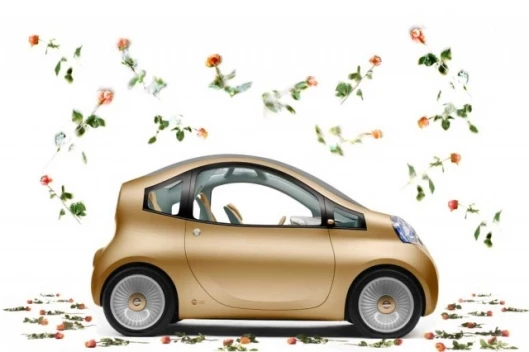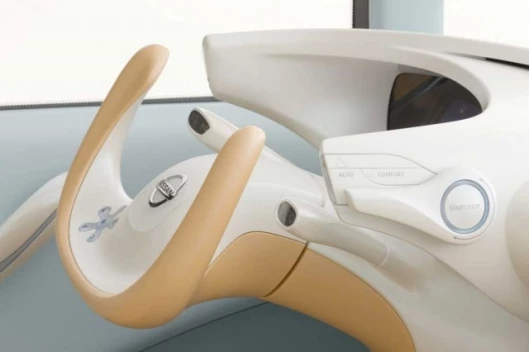October 8, 2008 Nissan has produced some very interesting concept cars in recent years – the Denki Cube, Pivo, Mixim and Pivo 2 just to name a few. Shown in Paris for the first time last weekend, the NuVu is a compact electric car specifically designed to make travelling comfortable in a gridlocked city. The idea is one of a moving urban oasis, with its own tree inside which provides shade for the interior, and generates solar energy via its ‘leaves.’ By-wire steering, unique 2+1 seating, a fast-charging Li-Ion battery and a rear-mounted electric motor system delivering a range of 125 kms and top speed of 120 km/h are among the key features of the Concept which, while not destined for production in its current form, is designed to showcase how a Nissan EV might look and what technology it might contain beyond 2010 when the company begins rolling-out electric cars in Japan and the US.
The Nuvu is described as "a more realistic interpretation of two of the most important aspects of its forerunners – the ‘Friendly Innovation’ found in Pivo 2 and the ‘Sports Dynamics’ central to Mixim" with the prime focus of the vehicle being its layout and use of space and what that has to offer in increasingly cramped urban environments where it's predicted that 55 percent of the world’s population will reside within the next five to seven years.
“Nuvu is literally a ‘new view’ at the future of the city car. It is electric, of course, but as far as Nissan is concerned, for tomorrow’s city cars that is a given. No, the most important aspect of Nuvu is the interior design which provides great comfort and space in an intelligent package designed to make best use of our crowded roads and limited parking slots,” says François Bancon, General Manager, Exploratory and Advance Planning Department, Product Strategy and Product Planning Division, Nissan Motor Co., Ltd.
To this end, the Concept stands at just over 1.5 meters tall and 3 meters long and seeks to combine easy to park agility with a roomy interior space. Two regular seats are supplemented by a third "occasional chair" that can be folded into the dashboard assembly when it's not required, leaving enough storage room for a serious trip to the supermarket. The hammock-like third seat also has a center section made from netting to further reduce overall weight. The interior layout results from the company's research into urban commuting which reveals that the driver is the only occupant of the vehicle 90 percent of the time, with one passenger present only five percent of the time and two passengers only four percent of the time - i.e. there is a great deal of wasted space in our current vehicle fleet. Developed by Nissan’s design think-tank Creative Box Inc., the car's design aims to combine the flowing, nature inspired lines of the interior "greenhouse" with an impression of strength and rigidity inherent on the lower body. The most striking feature is the ‘energy tree’. This interior 'trunk', which strikes as something Antoni Gaudi might have designed, rises from the luggage compartment floor to the roof behind the driver’s seat and extends to dozens of small solar panel 'leaves' under the glass roof. These both shade the occupants and assists the recharging system as well as providing an extra power boost for the electric motor. Nissan estimates that the solar panels will save the equivalent of one full overnight charge from mains electricity each month.
Natural, organic and recycled materials are also used extensively within the cabin in place of moulded plastics and synthetic elements. This includes a floor made from pressed wood fibers pressed and studded with rubber inserts made from recycled tyres. The windscreen and roof merge into one extended panel running virtually the entire length of the car to maximize natural light.
For the driver, steering, braking, transmission and throttle are ‘By-Wire’ with the steering controlled by an aircraft-style steering yoke which needs just one turn from lock to lock delivering agility and manoeuvrability in the city and a turning circle of only 3.7 meters. There are two pedals – for stop and go – stalks for minor controls and a digital instrument panel with dials for speed, distance covered and battery range.
Two screens on the dashboard display the view behind the car – there are no door mirrors to disturb the airflow, but small cameras – and double as monitors for the Around View Camera which give a bird’s eye view of the car when manoeuvering or parking.
Low-energy LED head and tail lamps are used to conserve energy and interestingly, the car goes further than just producing zero-local emission by incorporating a heating and ventilation system that actually filters and cleans the city air as it passes through the vehicle.
Because it is also a "fully working mobile test bed" for much of the technology that will be used in Nissan’s upcoming production EV, the NuVu's technical specification are being kept under wraps at present and there are no power and torque figures available. As mentioned above, Nissan has revealed that the Concept can cover 125 km on a single charge - more than ample for most urban commuters.
Details are similarly scarce on the battery system which will be of the latest laminated lithium-ion type and have a capacity of 140 Wh/kg (watt-hours per kilogram). The use of laminated Li-Ion battery boosts power by a factor of 1.5 at the same time as halving its physical size and twice the efficiency of conventional cylindrical Li-Ion battery but the total capacity of the batteries and number of modules are not being disclosed at this stage. A quick charge from empty to full should take between 10 to 20 minutes while a full charge should take between three to four hours from a domestic 220V socket. The small size of the batteries also enables them to be mounted under the seats to help keep the center of gravity as low as possible.
















































